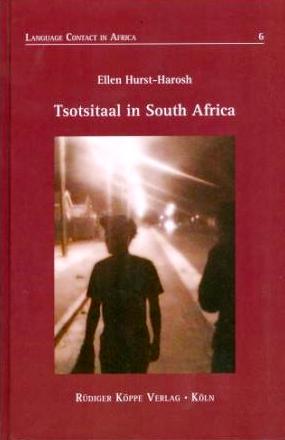
Tsotsitaal in South Africa
Style and Metaphor in Youth Language Practices
Author: Ellen Hurst-Harosh. Series edited by: Klaus Beyer, Henning Schreiber.
Series: LCA Language Contact in Africa Volume 6
202010 pp. Roman, 231 pp.
5 colour photos, numerous tables and charts, appendix: 1. A transcript of the speech and gesture in table, illustrates the varied and frequent gestures, 2. overview of Item / Meaning / Origin / Example, reading ribbon
Text language(s): English
Format: 160 x 240 mm
550 g
Hardcover
€ 69.80
Buy 'Tsotsitaal in South Africa' as a downloadable PDF document directly from our online shop »
Order 'Tsotsitaal in South Africa' as print edition »
Tsotsitaal studies, broadly defined as the study of youth speech registers in South Africa, is a field of South African sociolinguistics that has been garnering attention for several decades. This book draws together the findings of this field of study in one cohesive monograph. The book both maps a field and describes a linguistic phenomenon. Tsotsitaal is approached from a number of different perspectives: socio-historical, grammatical, lexical, and attitudinal. The main theoretical focus is on style and metaphor. The conceptualisation of Tsotsitaal as style and styling in language is the way the relationship between Tsotsitaal and the South African languages is conceptualised; while metaphor is the tool used to understand the lexicon of Tsotsitaal, beyond descriptions of slang. The book therefore aims to provide an overarching perspective on the phenomenon, and at the same time, contribute to the theoretical tools that can be used to study similar practices elsewhere – the creative language generated by youth in peer groups around the world.
The main chapters of the book describe the sociohistorical background to the Tsotsitaal phenomenon, the context of its emergence and development, and the conditions of its use today; the debates around the grammatical characteristics of Tsotsitaal, and its classification as a stylised register of an urban variety; perceptions of Tsotsitaal by both speakers and listeners, as well as the purpose or functions in use; the centrality of style and metaphor to Tsotsitaal including extra-linguistic markers, particularly gesture, and the centrality of relexicalisation in Tsotsitaal. The book offers possible future directions for Tsotsitaal and African Youth Language research.
Under these links you will find publications on African youth languages, a book review by Gardy Stein and further sociolinguistic studies:
Accompanying material:
- Aktuelle Forschungen zu afrikanischen Sprachen
(ISBN 978-3-89645-401-0 ) - APAL Annual Publication in African Linguistics
(ISBN 978-3-89645-503-1 ) - Beyond the Language Issue
(ISBN 978-3-89645-819-3 ) - Proceedings of the 4th WOCAL World Congress of African Linguistics, New Brunswick 2003
(ISBN 978-3-89645-338-9 ) - Proceedings of the 6th WOCAL World Congress of African Linguistics, Cologne, 17-21 August 2009
(ISBN 978-3-89645-199-6 )
Cross-reference:
- Codeswitching in Gambia
(ISBN 978-3-927620-24-7 ) - Ethnographie des Sprachwechsels
(ISBN 978-3-927620-25-4 ) - Fading Delimitations
(ISBN 978-3-89645-904-6 ) - From Rendille to Samburu
(ISBN 978-3-89645-911-4 ) - Language Contact in Guinea
(ISBN 978-3-89645-906-0 ) - Linguistic Landshapes
(ISBN 978-3-89645-085-2 ) - The Role of Wolof in Multilingual Conversations in the Casamance
(ISBN 978-3-89645-087-6 )
Reviews
Overall, this work is written in easily understandable wording, renouncing complicated constructions without loosing scientific appeal, thus making it accessible to laypersons as well as both academic beginners and advanced scholars. The book comes in a handy hard-back in shiny dark red including a slightly blurred cover picture of two young men walking down a street, and although an index is missing, the compact size of 203 pages (plus references and appendix) and a well-structured chapter division makes it easy to find individual readers’ special interests. A great contribution to African Urban Youth Language and especially Tsotsitaal studies!
Gardy Stein in Afrika und Übersee, 95/2022, 170-175
PDF documents:
 | Review by Gardy Stein | (≈ 103 kB) |
| « back | Print version | [top] |
 Books
Books Audio
Audio Biographies
Biographies Series
Series Festschrifts
Festschrifts Journals
Journals